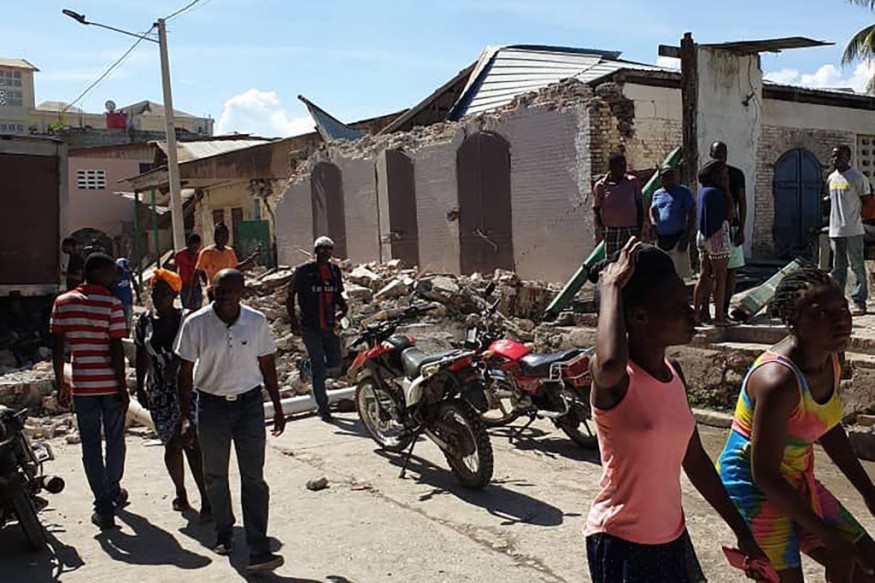More than 300 people died and hundreds more have gone missing in Haiti, which was struck by a 7.2-magnitude earthquake in the latest tragedy to strike a Caribbean country.
Bilan partiel: le séisme a provoqué la mort de 304 personnes :
— Pwoteksyon sivil (@Pwoteksyonsivil) August 14, 2021
✅ 160 dans le Sud
✅ 42 dans les Nippes
✅ 100 dans la Grand’Anse
✅ 2 dans le Nord-Ouest#Haïti#Séisme#MiseàJour
Reuters said the earthquake, which struck the country's southwest at 8:30 a.m. local time on Saturday, was felt throughout the Caribbean.
The same Reuters report added that at least 949 houses, seven churches, two hotels, and three schools had been damaged. More than 700 houses, one jail, three health centers, and seven schools were destroyed, with no substantial damage to port, airport, or telecommunications facilities.
The incident brought back terrible memories of the horrific 2010 quake, which killed over 200,000 people.

Haiti Located Along Hurricane Belt
Since then, Haiti has faced drought, cholera outbreaks, Hurricane Matthew in 2016, the 2018 earthquake, and other natural catastrophes.
Pan American Health Organization (PAHO) said Haiti is located in the hurricane belt with 1,100 miles (1,771 kilometers) of coastline. Hence, it is vulnerable to strong storms throughout the typical hurricane season from June 1 to November 30.
Haiti is particularly vulnerable due to its geographical location, underdevelopment, high population density, chronic socio-economic issues, and inadequate infrastructure. Natural catastrophes are more dangerous in impoverished nations, PAHO said citing UNDP's report. With a GDP per capita of $1,700, Haiti has some of the region's poorest health statistics.
Haiti's urban regions have become among the country's most susceptible places due to a lack of strong infrastructure and urban planning and a lack of adequate building processes.
Similarly, heavily populated regions along the shore that are located at low lying levels are already vulnerable to natural dangers from the sea and landslides and flashfloods caused by mountain runoff.
Furthermore, Haiti's health system is brittle and vulnerable, and it may be further overwhelmed in an emergency. Following catastrophes, immediate health considerations frequently include vector control as well as epidemiological surveillance.
Hurricanes, flooding, landslides, droughts, and earthquakes affect huge parts of the population every year. Wind damage, inland floods, and coastal surge are all major concerns due to hurricanes and tropical storms. In 2004, excessive rains resulted in two catastrophic floods, killing over 2,700 people, affecting over 300,0001 people, and destroying or severely damaging many hospitals and health institutions.
Sliding Plates
Live Science said earthquakes usually strike along the jigsaw-puzzle parts of the Earth's crust known as plates, which move relative to one another at a relatively moderate rate. The Caribbean and North American plates moved past one other in an east-west path during the Haiti earthquake. A strike-slip boundary is what this is called.
Tension builds up where portions of the crust stick along the boundary and along its faults; ultimately, that stress is released in a rapid, powerful movement that causes the two sides of the fault to move and create an earthquake. The Enriquillo-Plantain Garden fault system broke during the earthquake, causing the quake.
Major earthquakes are uncommon in this region of the world, in part because the Caribbean is a small plate with a fault system that isn't as lengthy as, instance, the San Andreas fault system, which is located at the intersection of two of the world's major plates, the Pacific and North American plates.
The quake's extremely high magnitude for this location is one of the reasons it is believed to have caused massive damage in Haiti.
Infrastructure Issues
The same Live Science report said that infrastructure involved in Haiti is another terrible component in the intensity equation.
The 1989 Loma Prieta earthquake, which struck San Francisco moments before Game 3 of the World Series, had a magnitude of 7.0. Despite the fact that it killed dozens of people and cost billions of dollars in property damage, the city's comparatively good building standards limited the destruction to a fraction of what it would have been in Haiti.
Experts predict that the death toll will likely be in the thousands, with tens of thousands of others left homeless.
Another issue is the relative rarity of big earthquakes in the area, combined with inadequate public communication and education, which means that most Haitians, like many Californians, were likely unprepared for such a tragedy.
RELATED ARTICLE : Mount Merapi Eruption 2021: Warning Signs of When a Volcano is About to Burst an Avalanche of Lava
Check out more news and information on Volcano in Science Times.











